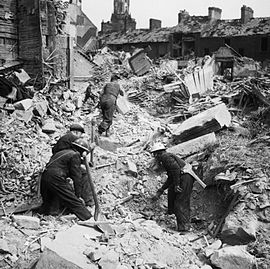The Blitz of Belfast 1941
At the beginning of World War Two, Belfast’s leaders believed that the city would be safe from aerial bombing because of its distance from London, however the Blitz of Belfast 1941 was to prove them wrong. However, the German invasion of France in the spring of 1940 made it possible for bombers flying from French bases to reach the city.
Belfast became a prime target for bombing. It contained some of the most vital industries to the war effort, such as Harland Wolff shipyards, which employed 35,000 people and manufactured destroyers, minesweepers and aircraft carriers. Belfast’s dock was central to these industries - it was the last port before the journey to America, making it the key destination for American supplies during the war.
30 November 1940 saw the first Luftwaffe reconnaissance flight over the city.
The first known Luftwaffe reconnaissance flight over Belfast was on 30 November 1940. The flights provided the Germans with photographs of the city’s layout, detailing the location of factories and anti-aircraft guns. There were only 22 anti-aircraft guns defending Belfast, compared to 100 AA guns in Liverpool.

This lack of defence was due to the government’s belief that North Ireland was too far for the Luftwaffe to be reached by the Luftwaffe.
There was also an attitude of complacency among the city’s population. Since the start of the war air raid sirens had gone off 22 times, but each one had been a false alarm. They paid less attention to blackouts as well and built only 200 air raid shelters for the whole city.
However, the peace wasn’t to last long. On 7 April 1941 the Luftwaffe launched its first attack. While most bombers headed towards Scotland, eight planes travelled to Belfast to test the defences in the city. They dropped 800 incendiary bombs which acted as markers for the other planes.
The raid destroyed many of the homes located near to factories and thirteen people in total were killed. The incendiary bombs also destroyed timber yards such and Harland and Wolff dockyards.
Before the next raid - known as the ‘Easter Raid - many of Belfast’s citizens took to the surrounding hills for safety at night time.
Around 56,000 homes were destroyed or damaged in the Easter Raid, which saw 150 bombers descend on the city. The government asked the Republic of Ireland to help the city after that raid, such was the extent of the damage.
The night of 4 May saw the next attack. More than 250 bombers attacked the city, dropping a total of 230 tons of bombs and 100,000 incendiary bombs. The historic Royal Avenue was damaged and aircraft factories were put out of commission for three months. The raid killed more than 200 people and destroyed a shelter, burying those inside under rubble.
Shortly after this, Hitler suspended the aerial bombing of Britain to focus on the upcoming invasion of Russia. It gave Belfast the opportunity to rebuild the docks and factories.
See also: The 1942 Bombing of York
MLA Citation/Reference
"The Blitz of Belfast 1941". HistoryLearning.com. 2026. Web.
